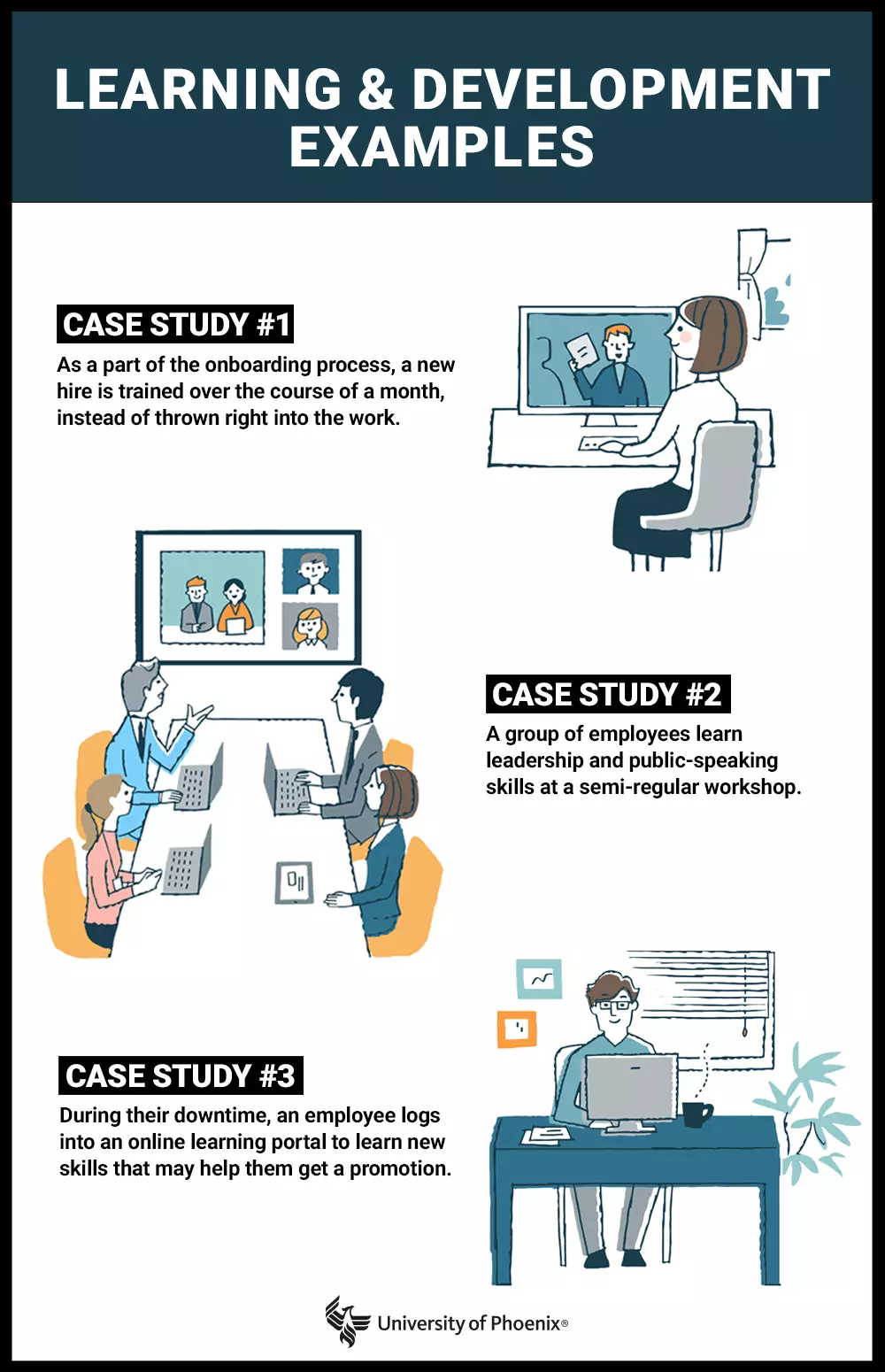The impact of corporate learning and development and how to take advantage

By Michael Feder
At a glance
- Learning and development emphasizes the personal growth of employees as the basis of business growth.
- The origins of learning and development go back to the Industrial Revolution.
- Learning and development can help in nearly every area of business development, including improved efficiency and workplace morale.
- According to a survey conducted for Training magazine of U.S.-based corporations with 100 or more employees, $82.5 billion was spent on training employees in 2020.
- A degree in business administration can help graduates learn how to develop a team and overcome business obstacles.
Workplace learning and development is a must-have
No matter where your business is positioned in its industry, it will largely be the talent, knowledge and skills of your employees that determine its future.
According to Training magazine, a survey of U.S.-based corporations with 100 or more employees revealed the companies spent $82.5 billion on training staff in 2020. Why? There’s value in cultivating employees’ skill sets and knowledge. It can help them approach problems with new insights and different perspectives. It can even help boost morale and foster a positive office culture.
In this article, we’ll be talking about learning and development, or L&D for short. This practice offers a unique perspective on business growth, one that emphasizes the personal growth of employees, whether that’s with technical training or soft-skill development.
Whatever the focus, the goal of L&D is to help employees perform better, all while finding more fulfillment and joy in their work. Let’s get started!
It takes hard work to develop a business, and it can be challenging to see where to start. A Bachelor of Science in Management from University of Phoenix prepares graduates with the skills they need to be leaders in a modern business landscape.
Where did learning and development come from?
Although L&D became relatively formalized in the 1970s, its origins go back as far as the Industrial Revolution when theorists sought to reduce the disorganization that plagued industrial working conditions.
Workers were often undertrained and tethered to repetitive tasks. They lacked the knowledge necessary to make creative decisions when faced with new challenges. Theorists sought to create rational systems that improved worker conditions and morale, all while boosting productivity.
World War II brought about systematic, on-the-job training thanks to the increased demand for proficient workers in factories. This education took the form of “by-the-book” training: standardized instruction designed to quickly bring workers to a level of competency. This training was focused mainly on the technical skills associated with factory work, and largely failed to take into account the individual psychology of workers.
After the war, this training and development mindset carried on, incorporating new discoveries made in psychology during the ’60s and ’70s. This was when L&D started to take a more humanistic approach, addressing employee needs of self-fulfillment and meaning in their work.
Since then, the L&D field has defined and refined techniques that accomplish the following (all while acknowledging that training cannot address every situation):
- Teach employees valuable skills
- Emphasize employee happiness
- Increase productivity and profit
What is learning and development?
In her book, Learning and Development, Rosemary Harrison writes, “The primary purpose of learning and development as an organizational process is to aid collective progress through collaborative and expert stimulation and facilitation of learning and knowledge that support business goals, develop individual potential and respect and build on diversity.”
What’s the difference between learning and development?
Learning can be defined as the process by which employees attain specific new skills that are useful to their work. These skills can be beneficial in both the short term and the long term.
Development largely focuses on long-term goals, such as fostering leadership and creativity in a work setting.
As you can see, the concept contains a dual emphasis on the immediate needs of employees to solve specific problems as well as long-term growth.
What are some examples of learning and development?
In these examples, employees develop new skills and experience that will benefit their work in both the short and long term. Whether at the very beginning of their employment or right in the middle, employees can use these skills to do their job better, improve their standing in their company and benefit from them in all walks of life.
Interested in making yourself an expert in business management? A Master of Business Administration (MBA) from University of Phoenix can be completed in as little as 18 months!
Why is learning and development important?
Even experienced employees do not always have the knowledge to tackle new problems. For example, in her book, Harrison cites experienced photocopier technicians. Although they had access to detailed instructions and training, their installed machines still broke down. It wasn’t until they talked to each other and shared their knowledge that they were able to overcome this obstacle.
Harrison writes: “The technicians shared this kind of knowledge as they exchanged stories of similar problems that they had encountered in the past and of how they had dealt with them. …This understanding was developed as much through their social interactions and conversations as through any technical know-how.”
Guidelines and instructions are important, but life has a way of presenting situations when you might as well throw out the handbook. New challenges and obstacles can come at any time, rendering initial training irrelevant.
In Harrison’s example, the technicians had no lack of learning when it came to the technical aspects of their work. Yet it took further development for them to conquer a new task that was not accounted for in their training.
L&D can also help in these major areas:
- Productivity
- Teamwork, morale and motivation
- Brainstorming
- Reducing bureaucracy and chokepoints
- Management and employee relations
L&D by the numbers
According to a 2020 industry report published in Training magazine, the average amount of training hours devoted by large companies (more than 10,000 employees) jumped from 38.8 hours per employee in 2019 to 102.6 in 2020!
The main driver of this increase, according to the industry report, was the COVID-19 pandemic. Due to the demand for remote work, more resources needed to be placed into training employees in remote, accessible ways. Employees also often required training on new technologies necessitated by remote work. Corporate training and development served a critical role in making the transition to remote work as smooth as possible.
Of the businesses that were surveyed, 54% indicated they would keep some of the remote learning processes instituted during the pandemic, even when returning to some in-person training.
The general shift toward remote retail also required more resources be devoted to training and developing employees in service roles, such as call centers staff.
Forty-three percent of surveyed businesses purchased new L&D technology and equipment, taking advantage of virtual learning platforms to quickly and efficiently train employees. These services are generally cheaper and more accessible than in-person training, making them attractive to businesses looking to emphasize L&D without incurring significant costs.
In the turbulent marketplace introduced by COVID-19, L&D has become a crucial aspect for keeping employees productive and engaged.
Who are the major stakeholders for L&D?
No matter where you are in a company, you’ll likely cross paths with L&D.
Human resources
Tasked with understanding the skills and training needs of an organization, HR departments tend to take point when it comes to L&D. They may design the overall structure of an L&D project, define its objectives and demonstrate its value to executives. A major point for HR is to design L&D programs that employees find value in and want to participate in.
Executive management
L&D is a great opportunity for executive management to connect with lower-level employees. Many L&D programs emphasize communication, connection and open dialogue, which create great opportunities for getting to know the real needs of your employees in a direct, face-to-face way. L&D gives executive management insight into the strengths of their employees, as well as where things could be improved.
Employees
Nearly every employee interacts with L&D in one form or another. From onboarding to on-site training, L&D can seem like a mandatory chore. But it doesn’t have to be that way! L&D is also an opportunity for employees to gain the skills necessary to grow in a company and remain viable in a changing business landscape.
Where should managers invest in L&D?
According to the industry report in Training magazine, here are the major areas where companies are investing in L&D.
Online learning tools
By moving aspects of L&D online, employers can offer employees the chance to learn without the need for in-person seminars or lengthy lectures. Easy-to-use online portals, for example, simplify conveying learning material to employees. Employees, meanwhile, benefit from being able to access them anytime, anywhere.
Learning management systems
Learning management systems allow HR departments to track the L&D process across a large number of employees. With this technology, companies can manage L&D content, draw insights from data trends and view L&D progress employee-by-employee.
With the multiple benefits of learning management systems, it’s no wonder that 41% of companies surveyed in the Training magazine poll intended to purchase such a system in 2021. That’s more than any other training product or service!
Content development
Figuring out the L&D needs of your company can be difficult, which is why many companies turn to outside contractors to help them develop L&D content for their employees. This content can come in a variety of forms, from helpful instruction guides to curricula.
And those are just the major areas! Others include:
- Presentation software and tools
- Mobile learning
- Certifications
- Performance support
- Even virtual reality!
How can I make sure L&D succeeds at my organization?
Many managers recognize L&D as an important aspect of their organization’s growth. At the same time, it might seem like a hard sell to other members of the organization. For L&D to work toward your business objectives, it cannot impinge on employee productivity, time-management or morale.
That’s why it’s so important to be thoughtful as you incorporate L&D into your business. Here are some suggestions for doing it successfully:
Assess exactly what your goals are
Going into L&D without a clear understanding of what you want to get out of it can lead to wasted time and disengaged employees. Make a list of clear objectives and think about where L&D can help.
Work with managers
If managers aren’t convinced of the value of L&D, you’ll be hard-pressed to convince the employees they manage. Demonstrating the value of L&D programs to managers first can help bring the rest of the team along.
Celebrate your successes
A great way to keep employees engaged is to show results. For instance, before a new L&D event, share with employees the kind of progress that was made in the last event. This can demonstrate to employees what they stand to gain by attending.
Listen to employee concerns
Many L&D events are mandatory, which can already sink morale for employees who would rather not attend. If they feel that their time is being wasted, and they have no one to take their concerns to, their engagement in L&D is unlikely to flourish. Create an open dialogue and address concerns as they come up. This can help foster trust and participation in learning and development.
L&D has taken on a new significance in recent years, and it’s easy to see why. Businesses are modernizing their approach to developing employees and recognizing how that development figures into a successful business future. These educational programs can help employees gain valuable skills and knowledge to tackle new problems with fresh solutions, all of which means L&D is no longer just nice to have. It’s a must-have.







